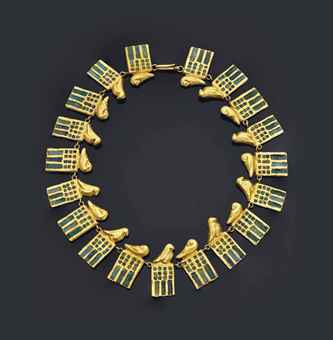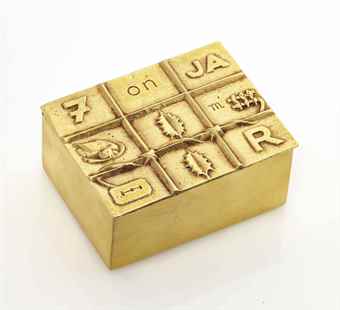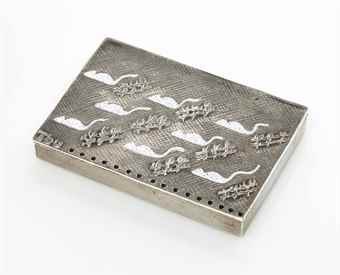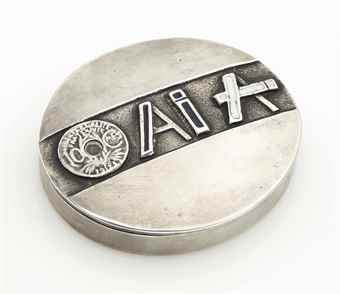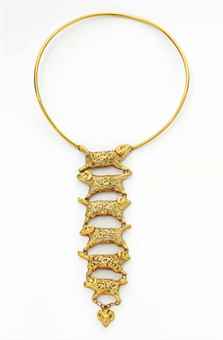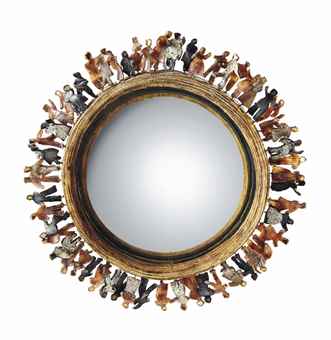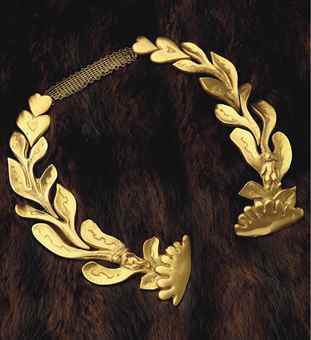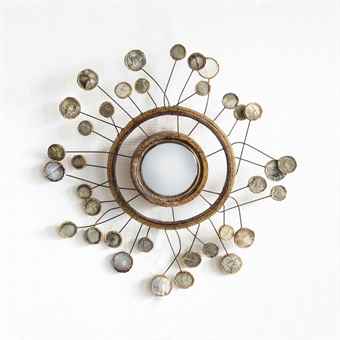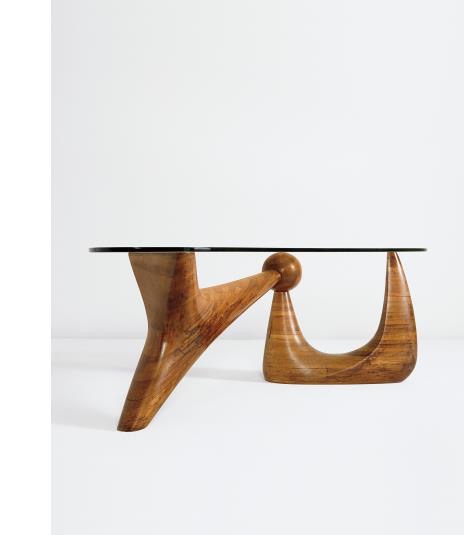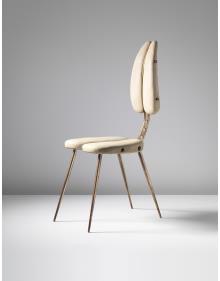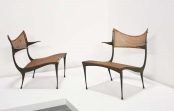Christie’s Paris held an auction of Line Vautrin’s work on May 20, 2015 with an array of jewels, boxes, sculptures and mirrors from the collection inherited by her daughter Marie Laure Bonnaud-Vautrin. Ms. Bonnaud-Vautrin wanted to celebrate her mother’s career by having this auction on what would have been her mother’s 100th birthday. Line Vautrin had several boutiques in Paris during her lifetime. Line Vautrin (1913-1997) was a highly respected industrial designer/manufacturer who used bronze to make most of her desirable boxes and jewels. She later used cellulose acetate-a plastic which she named “Talosel” to shape, carve and heat into lamp bases, screens and above all mirrors. This very special auction made numerous world record prices for her material.
Month: May 2015
Double Marshmallow Sofa
We are in the heart of the auction season. Wanted to tell you of another iconic mid century sofa being auctioned at Wright Auction house on May 19th. Estimate $ 50,000-70,000 dollars.
Designed by Irving Harper and George Nelson in 1954-1956, this piece of furniture was not a commercial success with approximately 186 sofas produced before discontinuing the original production in 1961. Less than a handful of the “double” sofas were produced.
Collecting Mid Century Masterpieces
Excellent article written by a good friend.
For the Love of Furniture: Collecting Mid-Century Masterpieces
BY JAMES ZEMAITIS, ART+AUCTION | MAY 02, 2015
Whether you are a collector, curator, scholar, dealer, or auctioneer, if you are passionate about design, you never forget the moments you first saw in person the things that make up your own “desert island” selection. You may not be able to personally possess them, but they haunt your memories as the years pass. The encounter may have happened before the object was canonized, if, for example, you stumbled across Marc Newson’s Lockheed Lounge in the lobby of the Paramount Hotel in the early 1990s. It may have happened during a pilgrimage to George Nakashima’s studio, set among the trees in New Hope, Pennsylvania, where you caressed the slabs of walnut in his shop. Or perhaps it was the time you spied the faint reddish outline of the joiner’s compass brand of Gustav Stickley on the underside of an unattributed Morris chair at some remote estate auction in the Adirondacks, hoping and praying that no one else had noticed.
I had one of those moments last December while visiting the exhibition for the single-owner auction at Phillips in New York mysteriously titled “The Collector: Icons of Design,” where I literally fell to my knees to run my hands over the stacked and laminated rosewood of one of the most legendary tables of the 20th century, Isamu Noguchi’s table for the A. Conger Goodyear house, executed in 1939. How glorious it was to actually touch what I had previously experienced only in Ezra Stoller’s period black-and-white photographs. How magnificent it was in person, so much larger than it appears in those photos, framed in the windows of Edward Durell Stone’s modern residential masterwork on Long Island. The boundless joy of attending design auction previews is the opportunity to cross the invisible gallery line and to stroke, perhaps even flip over, sit in, or hold up to the light. This incredible (and yes, at times even sensual) privilege of touch is something I have thought about again and again since donning the white gloves at the Indianapolis Museum of Art, where I have more than once set off the silent alarms in the galleries as I forgot my place and reached over to adjust a chair.
Rumor had it that the “Collector” who had put up most of the 33 lots was none other than Ronald S. Lauder. Though he has declined to confirm, it would not surprise me if the Goodyear table had wound up in Lauder’s hands. He is known in auction circles for his love of Noguchi, and I also recognized in the catalogue one of the few known examples of the designer’s in-70 cloud-form sofa (now paired with its even rarer ottoman, which had surfaced in an estate sale at Doyle New York, upholstered in a horrible mustard-and-ketchup-colored fabric). It set the auction record for postwar design when I was fortunate enough to sell it at Phillips in the spring of 2002 for $250,000, though of course, an auctioneer never reveals his clients.
It was around that time that I distinctly remember a private dealer showing me a color slide of the Goodyear table with a knowing wink. She implied that its owner, a retired dentist who had once owned the Goodyear house, was ready to sell it for an astronomical sum, which I believed it merited, since the table’s interlocking sculptural form was clearly a prototype for Noguchi’s most famous design, the IN-50 coffee table, which went into production after World War II. But if the table was sold, it was done so privately. As the years went by, other rare Noguchi designs came on the block, but I never received absolute confirmation that the Goodyear table had changed hands, or that it had been acquired by Lauder. While the Goodyear table was the unquestioned highlight at Phillips in December, the “Collector” sale also offered the finest group of works by Carlo Mollino to appear in decades. The sexually charged stiletto lines of Mollino posed a perfect complement to the biomorphic, sculptural curves of Noguchi. The offerings indeed appeared to have been culled from Lauder’s famously deep inventory. I recognized works acquired from Barry Friedman, starting in the 1990s; from several auctions, including my sale of Robert Rubin’s “Equipement Intérieur” collection at Sotheby’s in 2004, which introduced Le Corbusier’s India commissions to the market; and a Transat chair by Eileen Gray, which had inexplicably passed at Sotheby’s Paris in 2011 before reportedly being snapped up by the savvy consignor.
Considering the quality of these masterworks, it was somewhat surprising to me that they were being sold off in the first place, instead of ending up as promised gifts or fractional bequests to an institution like the Museum of Modern Art in New York, where Lauder has been a force on the Architecture and Design Committee for a generation. In some instances, the works being sold were already represented in MoMA’s permanent collection. Others by Josef Hoffmann and Adolf Loos are to be found in the Neue Galerie, Lauder’s museum of German and Austrian art and design. The case could also be made that several pieces were on the decorative side, such as Jean Royère’s furry and fashionable Ours Polaire upholstered suite of seating, of which numerous examples are to be found in the salons of New York’s leading contemporary art players. But when it comes to the table, Goodyear had been a trustee of MoMA, and his house had been designed by Stone, one of the museum’s original two architects. What were they thinking down on West 53rd Street, letting this seminal work, designed for one of their founding fathers, now owned by one of their largest benefactors, escape to the market after having been inaccessible for so many years?
The simple answer is that the museum had not prioritized that level of spending on a design object. Despite the growing popularity of design in the overall art market — indeed, that Carol Vogel of the New York Times even covered the sale in her weekly column was a badge of honor, so infrequently did she address 20th-century furniture — by and large museums and their patrons have not shown themselves consistently willing or able to spend the six or seven figures now necessary to acquire the absolute top works in the field.
At the same time, the design market is saturated with product. Hundreds of catalogues are produced per annum by five major houses in America alone, plus dozens of regional players — to say nothing of Europe, with the voluminous output of competing houses in Paris, London, and Scandinavia. It often takes a truly memorable single-owner sale — one such as “the Collector”— to stand out from the herd. Unlike the fine-art markets, where the Christie’s/Sotheby’s duopoly controls the highly choreographed ballet of the Imp/mod and contemporary sales, the design market is spread much thinner. The only sector of decorative arts that is subject to a similar binary is Tiffany lamps and glass, the best examples of which almost inevitably go to one of the two biggest houses. The benefits of the duopoly can be seen in the dedicated Tiffany sales, especially at Sotheby’s, where tightly edited selections lamps (usually fewer than 50 per season) with vetted, lengthy provenances that sometimes can be traced back 100 years to their original owners, achieve the highest average lot values of any genre or period in the design market.
For those willing to look for them, museum-quality gems can be found off the radar, whether it’s the Rose Valley table consigned from the estate of Arts & Crafts dealer Robert Edwards that emerged from a blurry jumble of stuff at Treadway Toomey in December, or the curated selection of the finest and rarest examples of Hans Wegner’s voluminous output, offered by Bruun Rasmussen of Copenhagen in honor of the Chair Man’s centennial (both in December 2014).
Even more serious than collector fatigue, though, is the lack of self-regulation and market policing that leads to some dubious decisions made by all the players in their attempts to stay relevant and move merchandise. Has anyone wondered why dozens of chairs by the obscure Nordic designer Philip Arctander have flooded the market over the past three years? Most are upholstered with a Royère-esque white shag. Most have re-lacquered wood legs with just the right amount of patina. None have any provenance, and only occasionally will a beleaguered cataloguer attempt to record a manufacturer or cite an unpaginated reference from an obscure Norwegian publication. Despite the lack of convincing backup, someone is always willing to pay $15,000 per chair, until inevitably one passes and the estimates start to tumble.
In contrast, the final prices achieved in the “Collector” auction were staggering. While Noguchi and Mollino have always been considered blue-chip names in 20th-century design, these new results were as mind-blowing — and precedent-setting — as the records achieved for French Art Deco from the Yves Saint Laurent collection at Christie’s Paris in 2009. The Goodyear table soared well beyond its aggressive estimate of $2 million to $3 million to set a new American design record of $4,450,500. Art+Auction’s Judd Tully reported speculation that the buyer was Alice Walton, which if true would represent a 21st-century update of Morgan selling to Frick, with the public institutions shut out. Bidding for a monumental cloud-form table from Ahmedabad, India, designed by architect Balkrishna Doshi with Le Corbusier, exploded beyond its $300,000-to-$400,000 estimate to a heretofore unfathomable $1,818,500, almost 10 years to the day after I sold it at Sotheby’s on behalf of Robert Rubin for $400,000. Another favorite of mine — a kinky brass Mollino side chair with a Resinflex seat and back so sensually shaped as to inspire dirty thoughts (originally part of a set that the Turinese auto-didact rather hilariously presented as a wedding gift to Lisa Licitra Ponti) — soared to $482, 500, just nine years after another example from Barbara Jakabson’s collection fetched $102,000 at Christie’s in her single-owner sale.
The moral of the story? A superbly curated single-owner sale of outstanding provenance, presented with all the bells and whistles Phillips could muster, is a major contender for the decade’s finest design auction. This is not to say that there have not been other outstanding single-owner sales elsewhere over the past year, or that the phenomenon is limited to organic modernism. In March 2014, Sotheby’s Paris triumphed with the €24,727,715 ($34.3 million) sale of the personal collection of legendary dealer Félix Marcilhac, offering French Art Deco works that in some cases had been off the market for 40 years.
But savvy buyers would do well not to overlook the various-owner presentations, despite their repetitive and voluminous nature. It was in such a sale, on June 12 last year at Christie’s New York, that the final chapter of midcentury modern pieces put up by Barry Friedman appeared. In contrast to the tired inventory sales the dealer had commanded at both Christie’s and Sotheby’s in the past, these objects had been the personal furniture of Barry and his wife, Patricia, installed in a Marcel Breuer house on the Hudson, which they had owned since the 1980s. Fellow furniture wonks recognized many pieces from the photographs in Cara Greenberg’s groundbreaking 1984 guide, Mid-Century Modern. The pieces were fresh. Their surfaces were original. The estimates were low. And it was a perfect scenario for the Indianapolis Museum of Art, which strengthened its midcentury holdings with two acquisitions: a zoomorphic yet neoclassical Gazelle high-back armchair designed by American designer Dan Johnson while living in Italy, and an iconic modernist office desk by George Nelson. Total price? Barely $10,000. This is not to say that either design is as sensational as Mollino’s chair for Lisa Ponti. But each work beautifully captures specific stylistic hallmarks of the period and fits my definition of “museum quality.”
A version of this article appears in the April 2015 issue of Art+Auction.
